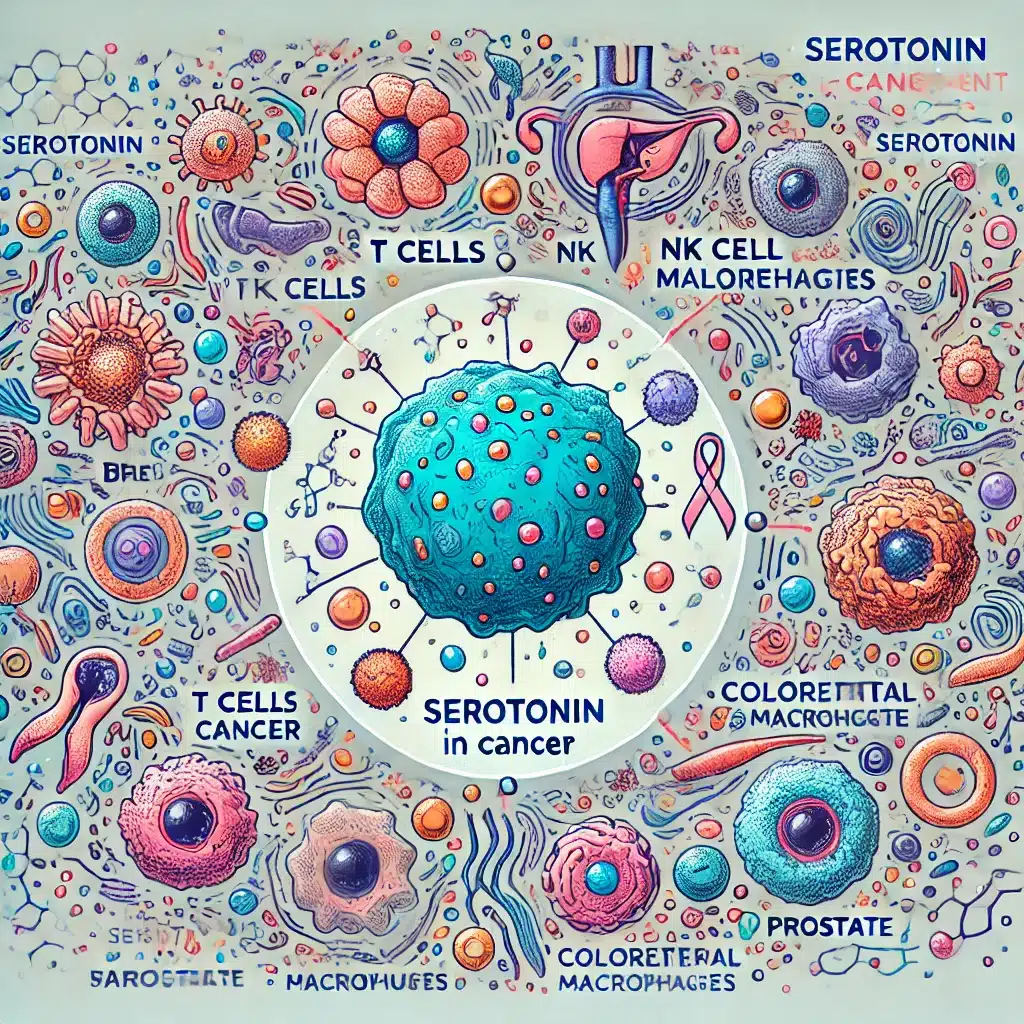Cancer patients frequently experience depressive symptoms, and the role of serotonin in tumor regulation varies across different types.
Highlights:
- Prevalence of Depression in Cancer Patients: A significant portion of cancer patients experience depressive symptoms, which are often linked to neuroendocrine hormone imbalances and decreased serotonin levels.
- Neuroimmunology’s Role: Neuroimmunology is an emerging field that has gained significant interest among tumor researchers for its unique insights into the relationship between psychosocial factors, immune function, and tumors.
- Serotonin’s Varied Effects on Tumors: The expression levels of serotonin, or 5-hydroxytryptamine (5-HT), exhibit varied effects across different types of tumors, indicating a complex regulatory role in tumor onset and progression.
- Potential for Novel Immunotherapy Targets: Further research into serotonin’s role in regulating anti-tumor immunity is anticipated to uncover new targets for developing immunotherapies.
Source: Pharmacological Research (2024)
Roles of Serotonin in Antitumor Immunity (2024 Insights)
Zhang & Wang highlight the roles of serotonin in anti-tumor immunity.
Serotonin, also known as 5-hydroxytryptamine (5-HT), is a neurotransmitter commonly known for its role in mood regulation.
However, it also plays significant roles in the immune system, particularly in the context of cancer and antitumor immunity.
1. Activation of T Cells
T Cells & Serotonin: T cells are a type of white blood cell essential for the immune response against tumors. Serotonin can serve as an autocrine and paracrine factor for T cells, meaning it can act on the same cell that releases it or nearby cells.
Receptor Interaction: Serotonin activates T cells through the 5-HT7 receptor, promoting their activation and enhancing their ability to attack tumor cells.
2. Enhancement of CD8+ T Cells’ Antitumor Function
CD8+ T Cells: These are specialized T cells that directly kill cancer cells. Serotonin, via the 5-HT7 receptor, enhances the activation and antitumor functions of CD8+ T cells, making them more effective in eliminating tumor cells.
3. Regulation of Inflammatory Responses
Inflammatory Environment: Inflammatory environments are common in cancer and can influence tumor progression. Serotonin modulates inflammatory responses by affecting T cell subsets such as Th1 and Th17 cells.
Cytokine Production: Serotonin can inhibit the production of pro-inflammatory cytokines like IL-17, IFN-γ, and GM-CSF by binding to 5-HT2B receptors on T cells, thereby reducing inflammation and potentially hindering tumor progression.
4. Influence on B Cells & Regulatory B Cells (Bregs)
B Cells: Serotonin promotes the proliferation and inhibits the apoptosis (programmed cell death) of B cells through the 5-HT1A receptor.
Bregs: Regulatory B cells (Bregs) can suppress excessive immune responses and inflammation. Serotonin activates Bregs via the 5-HT7 receptor, inducing them to produce IL-10, an anti-inflammatory cytokine that can help in controlling inflammation within the tumor microenvironment.
5. Natural Killer (NK) Cells Augmentation
NK Cells: These cells play a critical role in the early defense against tumors. Serotonin can enhance the activity and proliferation of NK cells through 5-HT2A receptors, boosting their ability to kill cancer cells.
Dual Role: However, excessive levels of serotonin can inhibit NK cell activity, indicating the need for balanced serotonin levels for optimal antitumor immunity.
6. Modulation of Macrophage Function
Macrophages: These immune cells can either promote or inhibit tumor growth depending on their activation state.
M1 Macrophages: Serotonin enhances the phagocytic (cell-eating) activity of M1 macrophages, which are known for their tumor-suppressing functions, through the 5-HT1A receptor.
Anti-Inflammatory Effects: Serotonin, via 5-HT2B receptors, can also promote anti-inflammatory effects in macrophages, contributing to a balanced immune response within the tumor microenvironment.
7. Neutrophil Recruitment & Function
Neutrophils: These are the most abundant type of white blood cells and play a role in inflammation and the immune response.
Recruitment: Serotonin helps recruit neutrophils to inflammation sites by increasing peripheral 5-HT levels, thus enhancing their ability to mount an immune response against tumor cells.
Inflammatory Modulation: Serotonin can modulate inflammatory responses through 5-HT1B/1D receptors, influencing neutrophil infiltration and activity.
Specific Cancers that May be Responsive to Serotonin Modulation (Possibilities)

Research indicates that certain types of cancers may be more responsive to serotonin modulation due to their unique interactions with serotonin and the immune system.
1. Breast Cancer
Serotonin Receptors: Breast cancer cells often express serotonin receptors (such as 5-HT1A and 5-HT2A), which can influence cell proliferation and apoptosis.
Immune Response: Serotonin can modulate the immune microenvironment of breast tumors, affecting the activity of immune cells such as T cells and macrophages.
Evidence: Studies have shown that serotonin can both promote and inhibit breast cancer growth depending on the receptor subtype activated and the tumor’s microenvironment. SSRIs have been observed to reduce breast cancer cell proliferation in some cases.
2. Lung Cancer
Neuroendocrine Factors: Lung cancers, especially small cell lung cancer (SCLC), often have neuroendocrine features and secrete serotonin.
Immune Modulation: Serotonin influences the immune response in the lung’s tumor microenvironment, affecting the activity of T cells and NK cells.
Evidence: Elevated serotonin levels have been associated with poor prognosis in lung cancer, suggesting that modulating serotonin could potentially improve outcomes. Serotonin antagonists have been shown to inhibit lung cancer cell growth and metastasis in preclinical studies.
3. Colorectal Cancer
Gastrointestinal Serotonin: The gastrointestinal tract is a major site of serotonin production. Colorectal cancer cells can express serotonin receptors, which influence tumor growth and immune cell function.
Inflammation: Serotonin can modulate the inflammatory response in the gut, impacting the development and progression of colorectal cancer.
Evidence: Research indicates that serotonin can promote the proliferation of colorectal cancer cells. Serotonin antagonists have shown potential in reducing tumor growth and enhancing the effects of chemotherapy.
4. Pancreatic Cancer
Serotonin Receptors: Pancreatic cancer cells often overexpress serotonin receptors, such as 5-HT2B, which can promote tumor growth and survival.
Metabolic Effects: Serotonin influences metabolic pathways in pancreatic cancer cells, including glycolysis, which is critical for their energy production and growth.
Evidence: Elevated serotonin levels and receptor expression have been correlated with poor prognosis in pancreatic cancer. Targeting serotonin signaling pathways has shown promise in preclinical models for reducing tumor growth and enhancing immune response.
5. Prostate Cancer
Proliferation & Apoptosis: Serotonin can influence the proliferation and apoptosis of prostate cancer cells through its receptors.
Immune Modulation: Serotonin affects the activity of immune cells in the prostate tumor microenvironment, such as macrophages and T cells.
Evidence: Studies have demonstrated that serotonin can both promote and inhibit prostate cancer cell growth, depending on the receptor subtype and cellular context. Modulating serotonin signaling has potential as a therapeutic strategy in prostate cancer.
Current Serotonergic Medications that May Help in Cancer Management

Several existing medications that modulate serotonin levels or receptors show potential in cancer management due to their effects on the immune system and tumor microenvironment.
1. Selective Serotonin Reuptake Inhibitors (SSRIs)
Common SSRIs: Fluoxetine (Prozac), Sertraline (Zoloft), and Citalopram (Celexa) are well-known SSRIs commonly used to treat depression and anxiety.
Mechanism: SSRIs increase the levels of serotonin in the brain by inhibiting its reuptake into presynaptic cells, making more serotonin available to bind to postsynaptic receptors.
Potential in Cancer Management:
- Enhancing Immune Response: SSRIs can boost the immune system by promoting the activation and proliferation of T cells and NK cells, which are crucial for attacking tumor cells.
- Managing Depression: They help manage cancer-related depression, improving overall patient well-being and potentially enhancing treatment adherence and outcomes.
2. Serotonin Receptor Antagonists
Examples: Ondansetron (Zofran), Granisetron (Kytril), and Palonosetron (Aloxi) are commonly used as antiemetics to prevent nausea and vomiting caused by chemotherapy.
Mechanism: These drugs block serotonin receptors (mainly 5-HT3 receptors) to prevent serotonin from binding and exerting its effects.
Potential in Cancer Management:
- Anti-Inflammatory Effects: By blocking serotonin receptors, these medications can reduce inflammation within the tumor microenvironment, potentially hindering tumor growth and progression.
- Improving Gastrointestinal Function: These drugs can help manage gastrointestinal symptoms in cancer patients, improving their quality of life and ability to undergo aggressive treatments.
3. Serotonin-Norepinephrine Reuptake Inhibitors (SNRIs)
Common SNRIs: Venlafaxine (Effexor), Duloxetine (Cymbalta), and Desvenlafaxine (Pristiq) are used to treat depression and anxiety by increasing the levels of both serotonin and norepinephrine in the brain.
Mechanism: SNRIs block the reuptake of serotonin and norepinephrine, enhancing their levels and effects in the brain.
Potential in Cancer Management:
- Immune Modulation: Similar to SSRIs, SNRIs can enhance the immune response against tumors by activating immune cells.
- Pain Management: These medications are also effective in managing neuropathic pain, a common issue in cancer patients, thereby improving their overall quality of life.
4. 5-HT3 Receptor Antagonists
Examples: Alosetron (Lotronex) and Ramosetron are used to treat irritable bowel syndrome (IBS).
Mechanism: These drugs block 5-HT3 receptors, primarily in the gastrointestinal tract, reducing the effects of serotonin in the gut.
Potential in Cancer Management:
- Gastrointestinal Protection: By modulating serotonin activity in the gut, these medications can help protect against chemotherapy-induced gastrointestinal damage, improving patients’ ability to tolerate treatment.
Conclusion: Serotonin vs. Cancer Tumor Growth
The paper by Zhang & Wang highlights the intricate role of serotonin (5-HT) in the regulation of tumor growth and the immune response in cancer patients.
Serotonin’s effects vary across different types of tumors, influencing immune cell activation, proliferation, and the inflammatory microenvironment.
The emerging field of neuroimmunology underscores the potential of serotonin modulation as a novel approach in cancer therapy.
Specifically, cancers such as breast, lung, colorectal, pancreatic, and prostate may be particularly responsive to serotonin-targeted treatments.
Further research into serotonin’s regulatory mechanisms could uncover new targets for immunotherapy, enhancing treatment efficacy and improving patient outcomes.
References









